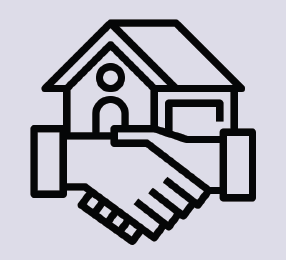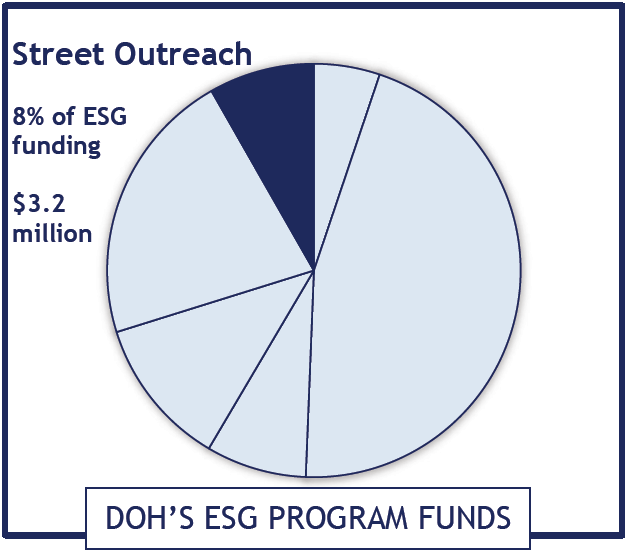Leading with Lived Expertise: Street Outreach
Overview of Street Outreach
Street outreach is the act of engaging people experiencing unsheltered homelessness where they are, which is often literally on the street, in encampments, or in other places not meant for human habitation. The role of street outreach teams is to build trust with individuals who might be unwilling or unable to access traditional homeless services, like emergency shelters. The goal is to connect people to services, housing, healthcare, and other essential survival tools they may need. The initial strategy, however, is often to focus building trust with those who do not trust systems or service providers so that they begin accessing available services, including housing. This mistrust often results from past experiences with homeless response systems that have not worked or that have directly exacerbated traumatic experiences.
ESG Currently Supports Street Outreach Programs by Paying for:
- Engagement, which includes the cost of activities to locate, identify, and build relationships with unsheltered homeless populations.
- Providing non-facility based services including case management, emergency health and mental health services, transportation, services for special populations like youth or those living with HIV/AIDS, or other urgent services.
- Connecting people to traditional services like emergency shelter, housing, or healthcare.
Recommendations for DOH’S ESG Street Outreach Programs
Individuals experiencing unsheltered homelessness are ready for housing without needing to go through shelter or facility-based programs (without having to prove that they are “housing ready”). Outreach workers should focus on building trust with people as opposed to primarily focusing on supporting those who are willing or ready to access services in order to increase positive outcomes. Outreach teams should prioritize the immediate health and safety of unsheltered populations and be prepared to offer immediate access to housing, shelter, or other services as soon as a person communicates their desire for that next step. DOH’s ESG program should incentivize outreach workers to consistently engage with people as needed to build trust. Successful outcomes should measure nuances around engaging the “hardest to house” populations and should encourage the use of peer support. This will create efficient programs that overcome barriers for people living in unsheltered situations who may be incorrectly perceived as “choosing homelessness” or being “hard to house”, even though that is not true.
The “3 E’s” for Creating Equity in Street Outreach
Empower
- Outreach work is a great opportunity for people with lived experience of homelessness to explore a career in the homeless response system. Create peer support programs in outreach work.
- Building trust and being consistent is key. Ask those with lived experience how to effectively reach out. If resources are limited, they can help prioritize efforts. Is it better to be active in any weather or should your program focus on a regular day and time? Should you only talk in person or should you use cell phones to connect to people 24/7?
- Strategize with individuals who have experiences of unsheltered homelessness about the best way to approach different people, groups, encampments, etc. Should services be designed to work one-on-one or with multi-disciplinary teams?
- Use lived experience to frame how services are offered. Should you have a meal with people or immediately talk about housing? How can you know the difference between which people need what approach?
- If an outreach worker has experience receiving services, it might encourage someone who does not trust the homeless response system to engage for the first time.
- Those who have lived outside will understand how to best find and approach those sacred, safe areas without feeling intrusive in someone’s home.
Engage
- Work with local partners to understand which trainings staff need for populations in your region. For example, if there is a high level of refugee resettlement in your community, you may need to find bilingual outreach workers and develop culturally sensitive outreach strategies.
- Research what outreach events other partners provide and collaborate to ensure housing-focused information and services are provided appropriately.
- Advocate for other providers to join outreach efforts as opposed to duplicating services. Are there field-based nurses who could join outreach to encampments? Are there parks or transportation staff who get called to respond to camps on public grounds? How are other outreach programs working together to ensure complete but not duplicative coverage?
- Understand the path that those without shelter take throughout your community every day. Where can they get meals? Where can they stay warm or cool during the year? Go there.
- Ask which services people who are unsheltered have difficulty accessing. If they need an address for Medicaid, partner with physical locations to get access to a mailbox. Help people do enroll-ment paperwork from their camp instead of having them come to an office and potentially be turned away for lack of eligibility.
Evaluate
Outreach workers walk a fine line to balance gaining trust from unsheltered populations while collecting real-time data that can be used for program evaluation and improvement. Data collection efforts in street outreach must center the input from those with lived experience to ensure that data collection can happen consistently without jeopardizing the ability to engage with those living in unsheltered situations.
That said, outreach programs must play an essential role in informing decision makers about the true scope of those living without shelter in their community. Outreach teams, more than other services providers, have the ability to:
- Get baseline demographic data of the unsheltered population on one given day, and over time.
- Understand the actual challenges faced by unsheltered populations. This insight should target services offered. What do individuals need to transition to housing and other services? How is that measured?
- Identify where those without shelter are engaging with community services to target outreach. Should services focus on emergency rooms, jails, or community meals? Why?
- Educate partners on why unsheltered populations refuse service or how many engagements they need to build trust. Only outreach workers can ask why folks are not engaging in traditional services available in communities.
More Impressions from the LEAG
Street outreach programs provide a bridge to critical housing navigation and survival supports. Many people are outside, camping, or living in cars because of limited access in shelter programs for the “3 P’s”: pets, partners, and possessions. Others have been to those programs and have been assaulted, made to feel inadequate, or asked to follow rules that directly contradict their physical ability, religious practices, or personal morals. Street outreach programs bridge the gap between people who have not been able to access programs and must adapt their approach for these populations. Programs should focus less on counting individuals or achieving “successful” outputs, and more on building relationships and trust with people who are isolated and don’t trust system engagement. While street outreach can cast a wide net, it should also be culturally responsive and trauma-informed to meet individuals where they are. Programs should be ready when individuals want to move to the next level of service provision, which is ideally permanent housing with tailored supports. In order to build trust that leads to permanent housing, street outreach teams can also provide access to resources like public benefits, Medicaid enrollment, and field-based healthcare. Street outreach programs must utilize lived experience and peer support in this strategy development and service delivery.
"A street approach is important, [specifically] integrating best practices that include a strengths-based approach. When I say street approach, I mean using language people understand. No one should be doing outreach to this community using ‘grant language’, but instead should talk to people with a similar level of experience of navigating to and through services."
Next Steps for DOH’S ESG Program: Street Outreach
In response to this input, DOH staff will:
- Create specific metrics to ensure that ESG-funded street outreach programs 1) prioritize the inclusion of lived experience in program development, 2) incentivize having multiple interactions with one person in order to build trust, and 3) directly connect street outreach to permanent housing at realistic rates, instead of focusing on the number of engagements, the quantity of data collected, or other outputs.
- Provide technical assistance tools for street outreach providers that are developed and reviewed by the LEAG members to ensure they meet the needs of people living in unsheltered situations.
- Implement monitoring tools that ensure all ESG-funded programs are focused on securing permanent housing where possible and utilizing lived experience to create trust for housing outcomes.
"In street outreach, connecting people to resource acquisition, case management, etc. is CRUCIAL. Often folks believe that ‘they can do it themselves and figure it out’, but this exiting from experiencing homelessness is COMPLEX and people need help."
